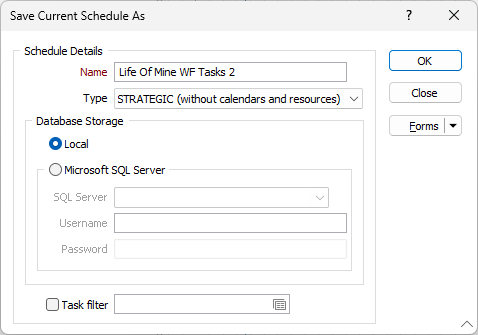Save & Save As
When you save a schedule, all the changes you have made (to calendars, attributes, tasks, resources etc.) are committed to the schedule database.
![]()
Save As
Click Save As to save:
-
a copy of the current schedule,
-
selected tasks from the current schedule as a new schedule,
-
a Strategic schedule as an Operational schedule,
-
or a package of the database, task wireframes and configuration files for the current schedule for transfer to another project, workstation or site.
![]()
Select the type of storage in which the new schedule is to be saved:
Save As
Select Save As | Save As to save the schedule as a new schedule within the current project, or to save a Strategic schedule as an Operational schedule.
When you select this option, the form shown below will be displayed:

Name
Enter the name for the new database in which the copy of the schedule should be stored.
Schedule Type
Select the type (OPERATIONAL / STRATEGIC) of schedule to be created.
The following types of schedules can be created:
|
Type |
Description |
|---|---|
|
OPERATIONAL |
Supports assignment of resources and calendars to tasks, and specification of working hours, exception dates, rates, efficiencies, calendars and productivity exceptions. |
|
STRATEGIC |
Uses optimisation techniques to best satisfy your objectives, with attributes constrained by capacity and/or grade for ranges of periods. Calendars and resources are not supported in Strategic schedules. |
This is a quick way to create a new schedule. While the tasks of the new schedule will be different, you may want to use the same calendars, resources and task types.
When you create a schedule, the files used by the schedule are maintained in a subfolder of the SchedulerDataFiles folder. The subfolder is given the name of the schedule plus a _files suffix. The files in this folder should not be modified.

Database Storage
Local
Select this option to create the database for the new schedule under the “SchedulerDataFiles” sub‑folder within the current project folder.
Microsoft SQL Server
Select this option to create the database for the new schedule in an existing instance of Microsoft SQL Server.
You will then be prompted to enter the details of the connection to the instance:
SQL Server
Enter the name of the Microsoft SQL Server instance in which the new database is to be created.
Username
Enter an authorised username for the specified Microsoft SQL Server instance. This user must have sufficient access rights to create, configure and add data to the new database.
Password
Enter the password required for the authorised user to access the Microsoft SQL Server instance.
Task Filter
Optionally, apply a Task Filter to select the tasks from the current schedule that are to be saved in the new schedule.